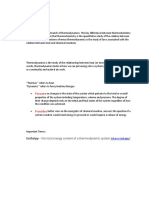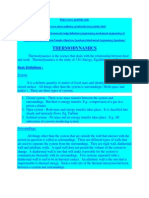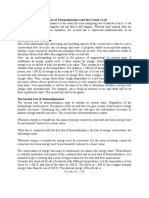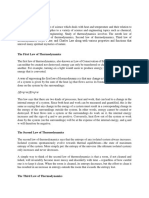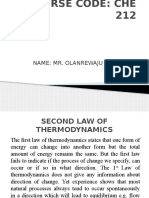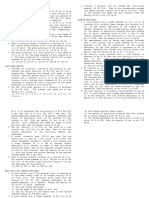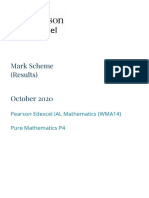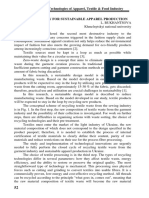0 ratings0% found this document useful (0 votes)
7 viewsTHERMODYNAMICS
THERMODYNAMICS
Uploaded by
ppt.joki.tugasCopyright:
© All Rights Reserved
Available Formats
Download as PPTX, PDF, TXT or read online from Scribd
THERMODYNAMICS
THERMODYNAMICS
Uploaded by
ppt.joki.tugas0 ratings0% found this document useful (0 votes)
7 views16 pagesCopyright
© © All Rights Reserved
Available Formats
PPTX, PDF, TXT or read online from Scribd
Share this document
Did you find this document useful?
Is this content inappropriate?
Copyright:
© All Rights Reserved
Available Formats
Download as PPTX, PDF, TXT or read online from Scribd
Download as pptx, pdf, or txt
0 ratings0% found this document useful (0 votes)
7 views16 pagesTHERMODYNAMICS
THERMODYNAMICS
Uploaded by
ppt.joki.tugasCopyright:
© All Rights Reserved
Available Formats
Download as PPTX, PDF, TXT or read online from Scribd
Download as pptx, pdf, or txt
You are on page 1of 16
Thermodynamics
Disusun Oleh:
Muhammad Naufal Adrian
Explanation
The Drinking Bird may seem like it can go on forever, with no
external source of energy powering it – in other words, a perpetual
motion machine. But the toy is not a perpetual motion machine –
because according to the laws of physics, continuous motion is
impossible. One reason is the first law of thermodynamics.
The main purpose
One of the main goals of thermodynamics is to describe energy
transfer. We have described two processes as the transfer of
energy – work and heat – and they are interconnected. When a
thermodynamic system works, it loses heat. When work is
done on a system, it gains heat. So heat is converted into work,
and work is converted into heat.
Main idea
The change in internal energy is equal to minus W, the work done on the closed
the change in work plus heat – so system. or by the system. It is important
fundamental that it is known as the first to remember that when we talk about
law of thermodynamics. So that we can changes in internal energy, if heat is
have an equation to use to analyze the transferred into the system, Q is
problem, we write the first law like this: positive, and if heat is transferred out of
The internal energy, U, of a closed the system, Q is negative. And if work is
system, is equal to Q, the heat transfer to done on the system, W is negative.
the system,
And if work is done by the system, then W is positive. Some
textbooks will change the signs, so it's a good idea to know
what the positive and negative meanings are. By now, you will
see that the first law of thermodynamics describes only those
two factors – work and heat – that influence changes in
internal energy.
So, the first law of thermodynamics is just one way to explain
the conservation of energy, which often appears in our lessons
because this law is a central principle of physics. There is
always heat loss, such as friction. Even a small amount means
the movement cannot continue forever. Ultimately, he will run
out of energy needed to carry out the work he does.
Lower first thermodynamics when applied to open
systems has tremendous applicability across industry.
Using this flow, you can predict what the pressure
drop across the nozzle will be or how much energy
the sperm needs to pump the fluid out or how hot it is.
heat transfer in the heat exchanger or how much work
is produced by this turbine. In short, the first law
means conservation of energy or states that energy
changed from one form to another.
here the cylinder has gas in it and it is assumed that
there is no air leakage to the surroundings so this is
an example of a closed system where the mass does
not change assuming this gas absorbs some of the
heat q from the surroundings it is also assumed that
this gas is able to push this piston upwards because
of the high gas pressure so that this gas does work
on the piston with the amount w there are two
energy interactions for this gas it absorbs a certain
amount of heat
Natural process
So, for example, if we put a metal rod between a
hot object and a cold object, then naturally heat
will flow from hot to cold, that's simply a natural
process. happens spontaneously Happens by itself
Heat doesn't flow naturally from cold to hot It just
doesn't happen.
The only way for that to happen is if you pump energy into the
system so for example a refrigerator will take some time taking
the heat energy out of the inside of the refrigerator and
pumping it outside and that's how the refrigerator can cool
those things inside but it takes energy to do it that matter.
How to make it happen
the way you make it happen is you have and for spontaneous processes the
to expend energy to get it over that hill increase in entropy will be greater than
and the same goes for heat heat doesn't zero and that is another statement of the
flow naturally from cold to hot now you second law of thermodynamics for
can make it happen you can pump heat natural processes changes in entropy
to warm a particular environment heat will be greater than zero natural systems
pumps do just that but require the energy tend towards disorder so for example if
to do so now as heat flows from hot to you clean your room it takes energy and
cold this is a spontaneous process energy to clean the room You naturally
tend to have a messy and dirty room and
things like that but it takes effort to
clean it
Conservation of energy
The first law explained most fundamentally
highlights the conservation of energy. Energy
is neither created nor destroyed, but only
changes form, from potential energy to kinetic
energy to heat energy, and so on.
Conservation of energy
The 2nd law introduces a new concept: entropy. entropy
is quite difficult to understand but we can easily
describe entropy as disorder, and the 2nd law states that
the sum of the entropy of a system and its environment
must always increase. in other words, the entropy or
disorder of the universe always increases, in a system
there is also a tendency towards higher entropy.
How energy is distributed in a system?
it is enthalpy, a thermodynamic quantity we studied
earlier that more accurately describes the energy of a
system. as we will see, enthalpy and entropy are closely
related to tell us something about the Gibbs free energy
of a system. G, or Gibbs free energy tells us whether a
process will occur spontaneously or not, meaning it just
happens.
Gibbs free energy change
The change in Gibbs free energy is given by this equation which includes the
change in enthalpy, change in entropy, and temperature. if delta G is negative
then the process is spontaneous, if positive then the process is not spontaneous.
so we can use this equation to see how a spontaneous process can be beneficial
enthalpically or entropically, or both, but not both. for example if delta H is
negative which means it is exothermic and energetically favorable, and delta S
is positive which means an increase in entropy which is also beneficial, then
negative minus positive will always be negative or spontaneous.
Terima Kasih
You might also like
- .Document4 pages.Dewi EkatantiNo ratings yet
- Module 1Document10 pagesModule 1Shefana RajaNo ratings yet
- S ThermodynamicsDocument15 pagesS ThermodynamicsJoselito UbaldoNo ratings yet
- Thermodynamics: Presented By: Jignasha PatelDocument21 pagesThermodynamics: Presented By: Jignasha PatelBhargavNo ratings yet
- College Physics 2e-WEB 7zesafu RemovedDocument4 pagesCollege Physics 2e-WEB 7zesafu Removednantespirlo123No ratings yet
- فيـزيـاء 5 ? عالم الصيدلةDocument9 pagesفيـزيـاء 5 ? عالم الصيدلةMohammed AbdulrahmanNo ratings yet
- FALLSEM2020-21 MEE1003 TH VL2020210103023 Reference Material I 31-Jul-2020 First Law of Thermodynamics - IIDocument52 pagesFALLSEM2020-21 MEE1003 TH VL2020210103023 Reference Material I 31-Jul-2020 First Law of Thermodynamics - IIRahul rajelliNo ratings yet
- 5 ThermodynamicsDocument16 pages5 Thermodynamicsabmusic711No ratings yet
- Lecture 2 The First Law of ThermodynamicsDocument84 pagesLecture 2 The First Law of ThermodynamicsArsal SohrabNo ratings yet
- Basic Thermodynamics Video To Text Lecture Notes 06 NptelDocument30 pagesBasic Thermodynamics Video To Text Lecture Notes 06 NptelKart01100% (2)
- The First Law of ThermodynamicsDocument4 pagesThe First Law of ThermodynamicsIan Dimayuga100% (1)
- Introduction To ThermodynamicDocument7 pagesIntroduction To Thermodynamicrskr_tNo ratings yet
- CBSE Class 11 Physics Chapter 12 Thermodynamics Revision NotesDocument38 pagesCBSE Class 11 Physics Chapter 12 Thermodynamics Revision NotesprofkimsiadaNo ratings yet
- UnitII-Fundamentals of ThermodynamicsDocument23 pagesUnitII-Fundamentals of ThermodynamicsBishwas GautamNo ratings yet
- PHY101 Introduction To ThermodynamicsDocument6 pagesPHY101 Introduction To Thermodynamicsidrisaminuabdullahi26No ratings yet
- 6. Thermodynamics and Thermochemistry -chem-1Document12 pages6. Thermodynamics and Thermochemistry -chem-1morsalinredoy420No ratings yet
- Engineering ThermodynamicsDocument28 pagesEngineering Thermodynamicsnagu nagaNo ratings yet
- Final ThermodynamicsDocument42 pagesFinal ThermodynamicsMaan LucsNo ratings yet
- Physics 110 Lecture 3 A Glimpse of Entropy: 1 Reversible and Irreversible ProcessesDocument11 pagesPhysics 110 Lecture 3 A Glimpse of Entropy: 1 Reversible and Irreversible ProcessesRahul BhattNo ratings yet
- FALLSEM2020-21 MEE1003 TH VL2020210103023 Reference Material I 29-Jul-2020 First Law of Thermodynamics - IDocument17 pagesFALLSEM2020-21 MEE1003 TH VL2020210103023 Reference Material I 29-Jul-2020 First Law of Thermodynamics - IRahul rajelliNo ratings yet
- Presentation of ThermodynamicsDocument19 pagesPresentation of Thermodynamicss18228230959No ratings yet
- Heat Thermodynamics SlidesDocument19 pagesHeat Thermodynamics SlidesMd. Ibrahim Sani 2211043642No ratings yet
- Chemical ThermodynamicsDocument46 pagesChemical Thermodynamicsgirishgangari8845No ratings yet
- Laws of ThermoDocument13 pagesLaws of ThermofabyunaaaNo ratings yet
- Thermo Review SheetDocument9 pagesThermo Review Sheets3rafinaeNo ratings yet
- SECOND LAW of ThermodynamicsDocument23 pagesSECOND LAW of ThermodynamicsDianne VillanuevaNo ratings yet
- Book Summary: A. The Nature of Energy and Types of EnergyDocument9 pagesBook Summary: A. The Nature of Energy and Types of EnergyFildzahNo ratings yet
- ThermodynamicsDocument9 pagesThermodynamicsMuhammed Muhasin. KNo ratings yet
- BasicsDocument65 pagesBasicsBas RamuNo ratings yet
- CHAPTER 3-Thermodynamics 2024Document29 pagesCHAPTER 3-Thermodynamics 2024obolmartin0No ratings yet
- Phy GSDocument6 pagesPhy GSAtomix EnergyNo ratings yet
- Molecules. in General, Thermal Energy Can Be Calculated From Temperature Measurements. TheDocument6 pagesMolecules. in General, Thermal Energy Can Be Calculated From Temperature Measurements. Thesari wahyuniNo ratings yet
- Thermodynamics: Basic DefinitionsDocument8 pagesThermodynamics: Basic DefinitionsAnu RadhaNo ratings yet
- INTRODUCTION (AutoRecovered)Document17 pagesINTRODUCTION (AutoRecovered)CherryNo ratings yet
- Physical Biochemistry Lecture NotesDocument9 pagesPhysical Biochemistry Lecture Noteschc300No ratings yet
- thẻmodynamicDocument8 pagesthẻmodynamicvanvui10No ratings yet
- Thermodynamics: Introduction To The Three Laws of ThermodynamicsDocument13 pagesThermodynamics: Introduction To The Three Laws of ThermodynamicsSangam Choudhary100% (1)
- Chapter 7Document15 pagesChapter 7Analie Buerano SagunNo ratings yet
- Law of ThermodynamicsDocument12 pagesLaw of ThermodynamicsDebapriya HazraNo ratings yet
- BCH 201 - DR Olalekan BakareDocument11 pagesBCH 201 - DR Olalekan BakareIbrahim AkindapoNo ratings yet
- 1st Law of ThermodynamicsDocument6 pages1st Law of ThermodynamicswilithNo ratings yet
- Lesson 1 Basics of Thermodynamics: Historical MilestonesDocument11 pagesLesson 1 Basics of Thermodynamics: Historical MilestonesJhonrick MagtibayNo ratings yet
- Unit II - Chemical ThermodynamicsDocument26 pagesUnit II - Chemical ThermodynamicshvacsriniNo ratings yet
- 2.0 Basic Concepts On ThermodynamicsDocument17 pages2.0 Basic Concepts On ThermodynamicsLeo JohnNo ratings yet
- XI CH 5 NotesDocument4 pagesXI CH 5 Notesiroonmaan123No ratings yet
- Laws - of Thermodynamics - NotesDocument1 pageLaws - of Thermodynamics - NotesAnudeep Reddy SolletiNo ratings yet
- Chapter - 6 - Thermodynamics-PHYS 352-BIOPHYSICSDocument86 pagesChapter - 6 - Thermodynamics-PHYS 352-BIOPHYSICSSara DabajaNo ratings yet
- UnitII-Fundamentals of Thermodynamics and Heat Transfer-Classnotes-PTDocument23 pagesUnitII-Fundamentals of Thermodynamics and Heat Transfer-Classnotes-PTBishwas GautamNo ratings yet
- Law's of ThermodynamicsDocument2 pagesLaw's of ThermodynamicsRoselyn BenavidezNo ratings yet
- ThermodynamicsDocument2 pagesThermodynamicsliezyl_15No ratings yet
- Che 212 Lecture NoteDocument39 pagesChe 212 Lecture NoteSeun AkinsanyaNo ratings yet
- First Law of ThermodynamicsDocument6 pagesFirst Law of ThermodynamicsFlorecel CaudillaNo ratings yet
- Chapter 7-Second LawDocument32 pagesChapter 7-Second LawIsrael EmmanuelNo ratings yet
- Basics of Thermodynamics & Heat: BE Civil I/IiDocument20 pagesBasics of Thermodynamics & Heat: BE Civil I/IiRabi SharmaNo ratings yet
- Thermodynamics.pptxDocument44 pagesThermodynamics.pptxGauravNo ratings yet
- Chemistry Official Reporting ThermodynamicsDocument54 pagesChemistry Official Reporting ThermodynamicsJohn Kennly SimNo ratings yet
- TPM Notes Final-2 PDFDocument247 pagesTPM Notes Final-2 PDFamarparimiNo ratings yet
- “Foundations to Flight: Mastering Physics from Curiosity to Confidence: Cipher 4”: “Foundations to Flight: Mastering Physics from Curiosity to Confidence, #4From Everand“Foundations to Flight: Mastering Physics from Curiosity to Confidence: Cipher 4”: “Foundations to Flight: Mastering Physics from Curiosity to Confidence, #4Rating: 5 out of 5 stars5/5 (1)
- A Letter To God: By:-G.L.FuentesDocument15 pagesA Letter To God: By:-G.L.Fuentesvidottma kolheNo ratings yet
- Ye Holiday Homework (Class XII)Document2 pagesYe Holiday Homework (Class XII)RohitNo ratings yet
- Protect Bristol BayDocument1 pageProtect Bristol BayadamfieldworkNo ratings yet
- WIND ENERGY Sample ProblemsDocument2 pagesWIND ENERGY Sample ProblemsROSE DIANE PILARESNo ratings yet
- 2020 October P4 MSDocument23 pages2020 October P4 MSMomen Yasser100% (1)
- Design Strategy For Sustainable Apparel ProductionDocument2 pagesDesign Strategy For Sustainable Apparel ProductionbukhantsovalvNo ratings yet
- GSAP Msds 01844305Document16 pagesGSAP Msds 01844305พีระพงค์ จิตวัฒนชัยNo ratings yet
- Saic A 1004Document2 pagesSaic A 1004Son AbanadorNo ratings yet
- Life Processes MCQDocument12 pagesLife Processes MCQDilbag khatKarNo ratings yet
- Odour Emission Factors For Assessment and PredictionDocument7 pagesOdour Emission Factors For Assessment and PredictiondiscolettoNo ratings yet
- Endoscopy Instruments Urology090521 FINALDocument5 pagesEndoscopy Instruments Urology090521 FINALSateesh KumarNo ratings yet
- TarotDocument3 pagesTarotChokkalingamNo ratings yet
- CII enDocument19 pagesCII enGa AnhgaNo ratings yet
- Notes NHFS Up To Cir. 25 2015 EMI CorrectedDocument34 pagesNotes NHFS Up To Cir. 25 2015 EMI CorrectedAnoop PS Sasidharan100% (1)
- Table of Density Values& Log ResponsesDocument1 pageTable of Density Values& Log Responsesgeo_mmsNo ratings yet
- AENG 521 - 3: Symmetrical & Unsymmetrical Flight Conditions Far Part 23 & 25Document11 pagesAENG 521 - 3: Symmetrical & Unsymmetrical Flight Conditions Far Part 23 & 25JonathanNo ratings yet
- TDS Cross 0432Document1 pageTDS Cross 0432palaxNo ratings yet
- 678 Lesson Plan SharifahDocument7 pages678 Lesson Plan SharifahorangramaiNo ratings yet
- Mình phải học vì mình yêu anh Đạo rất nhiềuDocument10 pagesMình phải học vì mình yêu anh Đạo rất nhiềuPhương PhạmNo ratings yet
- Vegetable Processing-Dpr-TmtpowderDocument42 pagesVegetable Processing-Dpr-Tmtpowdernarendar.naughtyNo ratings yet
- Jan 2023 CSEC Maths P2 SolutionsDocument35 pagesJan 2023 CSEC Maths P2 SolutionsRuqayyah Khan100% (1)
- NA-II Approved Notes.Document147 pagesNA-II Approved Notes.vishalNo ratings yet
- Fine Motor Skills in Patients With Parkinsons Disease: Effect of Auditory CueingDocument9 pagesFine Motor Skills in Patients With Parkinsons Disease: Effect of Auditory CueingRetno WulandariNo ratings yet
- Applications Used in Computers Using Coordinate GeometryDocument10 pagesApplications Used in Computers Using Coordinate Geometryyudhishther100% (1)
- Epson DFX-8500 Service ManualDocument236 pagesEpson DFX-8500 Service ManualBuddy HolliyNo ratings yet
- Jsa R B 6 ForkliftDocument3 pagesJsa R B 6 Forkliftoscar67% (3)
- Solas 1929Document64 pagesSolas 1929BGWebbie100% (1)
- Grammar Reference British CouncilDocument190 pagesGrammar Reference British CouncilAlfredo HernandezNo ratings yet
- Stars Academy Lahore: Stars Entry Test SystemDocument2 pagesStars Academy Lahore: Stars Entry Test SystemMemoona GullNo ratings yet
- Fuel Injectors: Denny Schroeter Injectors / Removal / Fitting 25/01/23Document14 pagesFuel Injectors: Denny Schroeter Injectors / Removal / Fitting 25/01/23Евгений МуллаяновNo ratings yet


